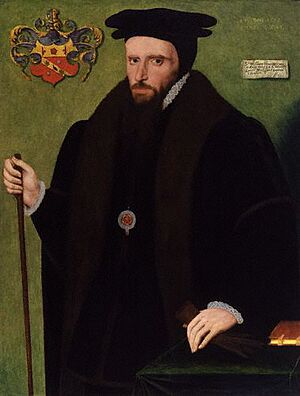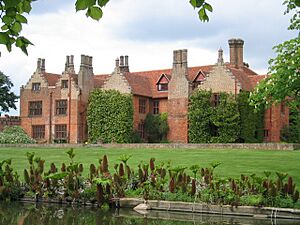Ingatestone Hall facts for kids
Quick facts for kids Ingatestone Hall |
|
|---|---|

Ingatestone Hall in 2015
|
|
| General information | |
| Type | Country House |
| Architectural style | Tudor |
| Town or city | Ingatestone, Essex |
| Country | United Kingdom |
| Coordinates | 51°39′41.5″N 0°23′25.3″E / 51.661528°N 0.390361°E |
| Construction started | 1539 |
| Completed | 1556 |
| Technical details | |
| Material | English bond brickwork |
| Designations | Grade I listed |
Ingatestone Hall is a very old and important house in Essex, England. It was built in the 1500s and is known as a manor house. You can find it just outside the village of Ingatestone, about 8 kilometres (5.0 mi) from Chelmsford and 40 kilometres (25 mi) from London.
Sir William Petre built this house, and his family, the Petres, still live there today. Some parts of the house are rented out as offices. The house has a long history, even hosting famous people like Queen Elizabeth I in the past.
You can visit Ingatestone Hall on certain afternoons between Easter and September.
Contents
History of Ingatestone Hall
How the Hall Began
Sir William Petre bought the land for Ingatestone Hall after the Dissolution of the Monasteries. He paid about £850 for it. Soon after, he started building the grand house we see today.
Royal Visits and Important Guests
In June 1561, Queen Elizabeth I stayed at Ingatestone Hall for several nights. She held her royal court there. The Petre family made sure she had a wonderful welcome. They provided lots of food and drink and decorated the house beautifully.
Later, in November 1564, Lady Katherine Gray was placed in Sir William Petre's care. She lived at Ingatestone Hall for two years.
A Secret Place for Faith
The Petre family were Catholics. This was a difficult time in England because the country had become Protestant. Laws were made against Catholic worship. People who practiced Catholicism faced serious punishments.
Like many noble Catholic families, the Petres worshipped in secret. They held private Catholic services in their chapel at Ingatestone Hall.
Music and Hidden Priests
John Petre, 1st Baron Petre, who was the first Baron Petre, became friends with the composer William Byrd. Byrd was also Catholic. In 1589–90, Byrd spent Christmas with the Petre family at Ingatestone.
Byrd helped the Petre family with their secret Catholic worship. He wrote many pieces of choral music for their private chapels. These songs were first heard at Ingatestone Hall. Today, they are considered some of the best examples of Tudor music.
The Petre family also hid Catholic priests at Ingatestone Hall. One of these priests was St. John Payne, who was executed in 1582. The house has two secret hiding places, called priest holes. These were used to keep Catholic clergy safe from danger.
Changes Over the Years
In the late 1700s, Robert Petre, 9th Baron Petre moved the family to another property called Thorndon Hall. Ingatestone Hall was then rented out to other people.
In 1876, a large part of Thorndon Hall was destroyed by fire. During World War I, Lionel Petre, 16th Baron Petre was killed in 1915. His wife, Lady Rasch, decided to move back to Ingatestone Hall.
During the Second World War, Wanstead High School used the house. In the 1950s, Essex County Council used the north wing for the Essex Record Office. They held yearly exhibitions there until the late 1970s.
In 1952, Ingatestone Hall was given a special "Grade I listed" status. This means it is a very important historical building. The gatehouse also became "Grade II* listed."
Today, Ingatestone Hall still holds the Petre family's collection of pictures.
Architecture of Ingatestone Hall
Building Design and Features
Ingatestone Hall has three main sections: the north, east, and south wings. These wings are built around a central courtyard. Sir William Petre built the house between 1539 and 1556. It is made of brick and has features typical of Tudor architecture. These include stepped gables and tall, fancy chimneys.
Inside the courtyard, there is a tall, crenellated tower. This tower has an octagonal staircase inside it.
Later Changes and Restorations
In the late 1700s, Ingatestone Hall was changed quite a bit. The west wing, which had the Great Hall, was taken down. This changed the enclosed courtyard into the U-shaped building you see today. The north wing was also made longer.
The outer buildings were rebuilt, including an entrance arch with a special one-handed clock on top. This clock has the motto "Sans dieu rien" ("without God, nothing") carved on it.
The Long Gallery in the east part of the house was a very important area. It is next to what is left of the old family chapel. The two priest holes in the building are in the east wing and the south wing. They were used to hide Catholic priests in the 1500s and 1600s.
In the 1900s, Lady Rasch decided to bring the family back to Ingatestone Hall. She started a big project to make the house look like it did in Tudor times. This included putting back features that had been changed. The first part of this restoration was finished in 1922.
Ingatestone Hall in Books and Movies
Featured in Literature
The 1862 novel Lady Audley's Secret by Mary Elizabeth Braddon is partly set at a place called Audley Court. This fictional place was inspired by Ingatestone Hall, after the author stayed there.
Seen on Screen
The outside of Ingatestone Hall was used as a filming location for the TV show Bleak House in 2005. This show was based on Charles Dickens' novel. The Hall also appeared in an episode of the TV series Lovejoy.
See also
- Ingatestone
- John Patrick Lionel Petre, 18th Baron Petre





